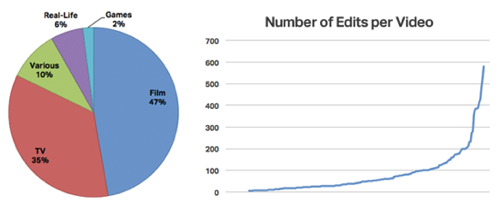Supercut Genre
Technology continues to create new genres of media. A short list of new media genres in the past few decades would have to include:
The 18 minute PowerPoint presentation (a la TED)
LOL Cats
100-Plus-Hour Serial Dramas (Lost, the Wire, Sopranos)
1-page Blog Post
Fan-Fic Novels
Remixed Movie Trailers
40-Hour Video Game
Bad Lipsyncs
3 Minute Funny Clips (You Tube)
140-Character Tweets
A Book of Tweets
Video Supercuts
The last of these, Video Supercuts, is still an embryonic art form. A supercut is a video montage cut and sequenced from existing movies and TV and commercials. It creates a rapid-fire medley of shots representing a theme of some sort. Supercuts highlight cliches in movies, or repetitions by a director, actor, or character, or in their most creative use, a supercut will reveal unseen patterns in our visual record. As an example, imagine the US President’s State of the Union speech without the speech — only the bits where no one is talking. Or image every entrance of Kramer in Seinfeld in chronological order. Or every nickname uttered by Sawyer in Lost.
Palin’s Breath from wreckandsalvage on Vimeo.
Why? Because technology makes it easy. But also because there are patterns to be found. Three technologies make supercuts possible: The large reservoir of videos and audiences on YouTube; ubiquitous easy video editing software; transcripts for searching for key words and ideas. The supercuts genre has found its curator in Andy Baio who has posted every supercut he has found on a new site supercut.org. There are currently 160 different supercuts.
Baio has also written up a fantastic short history of this emerging genre, or what he calls “An Anatomy of a Meme.” He says:
Brooklyn-based critic Tom McCormack wrote the definitive history of the supercut, tracing its origins back to found-footage cinema, like Bruce Conner’s A MOVIE from 1958.
But it wasn’t until the 1990s that clear descendants of the genre emerged. Matthias Müller’s Home Stories (1990) reused scenes from 1950s- and 1960s-era Hollywood melodramas, filmed directly from the TV set, to show actresses in near-identical states of distress.
He used Amazon Turk researches to help him classify and analyze attributes of the new genre. For instance he discovered the average supercut consists of 82 cuts.

As super cuts become more common — and become part of the cultural vocabulary — I think they will help keep cliches from getting old, and will help creators and the audience perceive recurring patterns in rapid turnaround. They will act as keen proofreaders and critics. At the same time a few super cutters will employ existing footage to create entirely new feature-length works. A few classic experimental films have already been cut from found footage, but we can expect more of these, and better ones.


